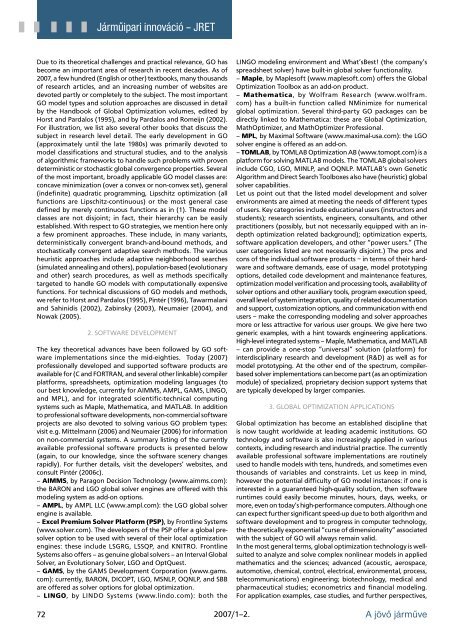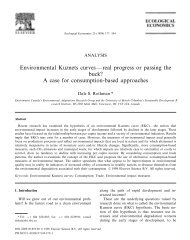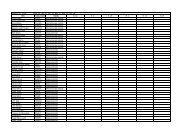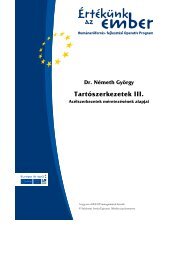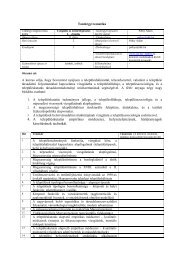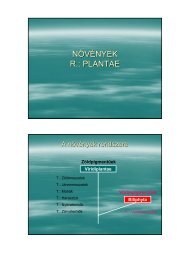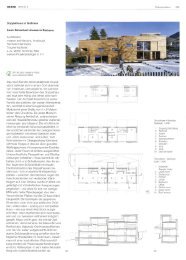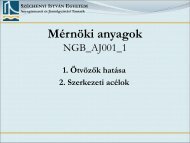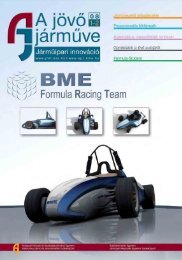2007/1–2 - Széchenyi István Egyetem
2007/1–2 - Széchenyi István Egyetem
2007/1–2 - Széchenyi István Egyetem
You also want an ePaper? Increase the reach of your titles
YUMPU automatically turns print PDFs into web optimized ePapers that Google loves.
72<br />
Járműipari innováció – JRET<br />
Due to its theoretical challenges and practical relevance, GO has<br />
become an important area of research in recent decades. As of<br />
<strong>2007</strong>, a few hundred (English or other) textbooks, many thousands<br />
of research articles, and an increasing number of websites are<br />
devoted partly or completely to the subject. The most important<br />
GO model types and solution approaches are discussed in detail<br />
by the Handbook of Global Optimization volumes, edited by<br />
Horst and Pardalos (1995), and by Pardalos and Romeijn (2002).<br />
For illustration, we list also several other books that discuss the<br />
subject in research level detail. The early development in GO<br />
(approximately until the late 1980s) was primarily devoted to<br />
model classifications and structural studies, and to the analysis<br />
of algorithmic frameworks to handle such problems with proven<br />
deterministic or stochastic global convergence properties. Several<br />
of the most important, broadly applicable GO model classes are:<br />
concave minimization (over a convex or non-convex set), general<br />
(indefinite) quadratic programming, Lipschitz optimization (all<br />
functions are Lipschitz-continuous) or the most general case<br />
defined by merely continuous functions as in (1). These model<br />
classes are not disjoint; in fact, their hierarchy can be easily<br />
established. With respect to GO strategies, we mention here only<br />
a few prominent approaches. These include, in many variants,<br />
deterministically convergent branch-and-bound methods, and<br />
stochastically convergent adaptive search methods. The various<br />
heuristic approaches include adaptive neighborhood searches<br />
(simulated annealing and others), population-based (evolutionary<br />
and other) search procedures, as well as methods specifically<br />
targeted to handle GO models with computationally expensive<br />
functions. For technical discussions of GO models and methods,<br />
we refer to Horst and Pardalos (1995), Pintér (1996), Tawarmalani<br />
and Sahinidis (2002), Zabinsky (2003), Neumaier (2004), and<br />
Nowak (2005).<br />
2. SOFTWARE DEVELOPMENT<br />
The key theoretical advances have been followed by GO software<br />
implementations since the mid-eighties. Today (<strong>2007</strong>)<br />
professionally developed and supported software products are<br />
available for (C and FORTRAN, and several other linkable) compiler<br />
platforms, spreadsheets, optimization modeling languages (to<br />
our best knowledge, currently for AIMMS, AMPL, GAMS, LINGO,<br />
and MPL), and for integrated scientific-technical computing<br />
systems such as Maple, Mathematica, and MATLAB. In addition<br />
to professional software developments, non-commercial software<br />
projects are also devoted to solving various GO problem types:<br />
visit e.g. Mittelmann (2006) and Neumaier (2006) for information<br />
on non-commercial systems. A summary listing of the currently<br />
available professional software products is presented below<br />
(again, to our knowledge, since the software scenery changes<br />
rapidly). For further details, visit the developers’ websites, and<br />
consult Pintér (2006c).<br />
– AIMMS, by Paragon Decision Technology (www.aimms.com):<br />
the BARON and LGO global solver engines are offered with this<br />
modeling system as add-on options.<br />
– AMPL, by AMPL LLC (www.ampl.com): the LGO global solver<br />
engine is available.<br />
– Excel Premium Solver Platform (PSP), by Frontline Systems<br />
(www.solver.com). The developers of the PSP offer a global presolver<br />
option to be used with several of their local optimization<br />
engines: these include LSGRG, LSSQP, and KNITRO. Frontline<br />
Systems also offers – as genuine global solvers – an Interval Global<br />
Solver, an Evolutionary Solver, LGO and OptQuest.<br />
– GAMS, by the GAMS Development Corporation (www.gams.<br />
com): currently, BARON, DICOPT, LGO, MSNLP, OQNLP, and SBB<br />
are offered as solver options for global optimization.<br />
– LINGO, by LINDO Systems (www.lindo.com): both the<br />
LINGO modeling environment and What’sBest! (the company’s<br />
spreadsheet solver) have built-in global solver functionality.<br />
– Maple, by Maplesoft (www.maplesoft.com) offers the Global<br />
Optimization Toolbox as an add-on product.<br />
– Mathematica, by Wolfram Research (www.wolfram.<br />
com) has a built-in function called NMinimize for numerical<br />
global optimization. Several third-party GO packages can be<br />
directly linked to Mathematica: these are Global Optimization,<br />
MathOptimizer, and MathOptimizer Professional.<br />
– MPL, by Maximal Software (www.maximal-usa.com): the LGO<br />
solver engine is offered as an add-on.<br />
– TOMLAB, by TOMLAB Optimization AB (www.tomopt.com) is a<br />
platform for solving MATLAB models. The TOMLAB global solvers<br />
include CGO, LGO, MINLP, and OQNLP. MATLAB’s own Genetic<br />
Algorithm and Direct Search Toolboxes also have (heuristic) global<br />
solver capabilities.<br />
Let us point out that the listed model development and solver<br />
environments are aimed at meeting the needs of different types<br />
of users. Key categories include educational users (instructors and<br />
students); research scientists, engineers, consultants, and other<br />
practitioners (possibly, but not necessarily equipped with an indepth<br />
optimization related background); optimization experts,<br />
software application developers, and other “power users.” (The<br />
user categories listed are not necessarily disjoint.) The pros and<br />
cons of the individual software products − in terms of their hardware<br />
and software demands, ease of usage, model prototyping<br />
options, detailed code development and maintenance features,<br />
optimization model verification and processing tools, availability of<br />
solver options and other auxiliary tools, program execution speed,<br />
overall level of system integration, quality of related documentation<br />
and support, customization options, and communication with end<br />
users − make the corresponding modeling and solver approaches<br />
more or less attractive for various user groups. We give here two<br />
generic examples, with a hint towards engineering applications.<br />
High-level integrated systems – Maple, Mathematica, and MATLAB<br />
– can provide a one-stop “universal” solution (platform) for<br />
interdisciplinary research and development (R&D) as well as for<br />
model prototyping. At the other end of the spectrum, compilerbased<br />
solver implementations can become part (as an optimization<br />
module) of specialized, proprietary decision support systems that<br />
are typically developed by larger companies.<br />
3. GLOBAL OPTIMIZATION APPLICATIONS<br />
Global optimization has become an established discipline that<br />
is now taught worldwide at leading academic institutions. GO<br />
technology and software is also increasingly applied in various<br />
contexts, including research and industrial practice. The currently<br />
available professional software implementations are routinely<br />
used to handle models with tens, hundreds, and sometimes even<br />
thousands of variables and constraints. Let us keep in mind,<br />
however the potential difficulty of GO model instances: if one is<br />
interested in a guaranteed high-quality solution, then software<br />
runtimes could easily become minutes, hours, days, weeks, or<br />
more, even on today’s high-performance computers. Although one<br />
can expect further significant speed-up due to both algorithm and<br />
software development and to progress in computer technology,<br />
the theoretically exponential “curse of dimensionality” associated<br />
with the subject of GO will always remain valid.<br />
In the most general terms, global optimization technology is wellsuited<br />
to analyze and solve complex nonlinear models in applied<br />
mathematics and the sciences; advanced (acoustic, aerospace,<br />
automotive, chemical, control, electrical, environmental, process,<br />
telecommunications) engineering; biotechnology, medical and<br />
pharmaceutical studies; econometrics and financial modeling.<br />
For application examples, case studies, and further perspectives,<br />
<strong>2007</strong>/<strong>1–2</strong>. A jövő járműve


